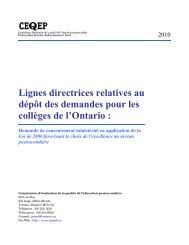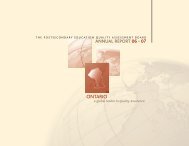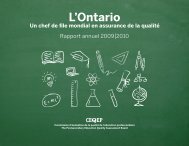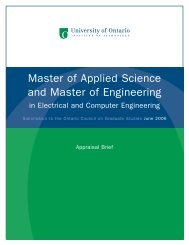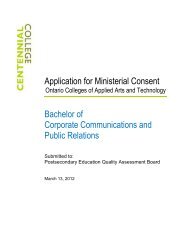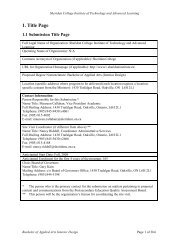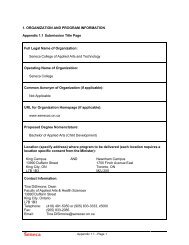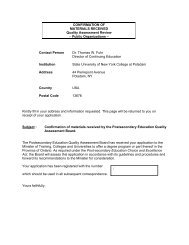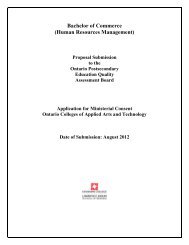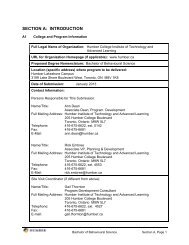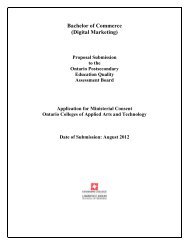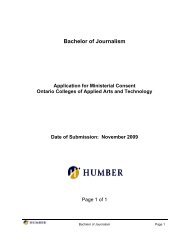Master of Business Administration (Financial Services)
Master of Business Administration (Financial Services)
Master of Business Administration (Financial Services)
- No tags were found...
You also want an ePaper? Increase the reach of your titles
YUMPU automatically turns print PDFs into web optimized ePapers that Google loves.
Assessment Report <strong>of</strong> Dalhousie University’s Quality Assurance Policies and Procedures 13APPENDIX 1DALHOUSIE UNIVERSITY’S RESPONSE TO THE ASSESSMENT OF ITS QUALITY ASSURANCEPOLICIES AND PROCEDURES, SEPTEMBER 2003Dalhousie University was grateful for the opportunity to participate in the pilot phase <strong>of</strong> the MPHEC’s quality assurancemonitoring process. The self-reflection required for the preparation <strong>of</strong> the self-study document and our consideration <strong>of</strong>the report <strong>of</strong> the AAU-MPHEC Quality Assurance Monitoring Committee will result in improvements to the already rigorousacademic quality assurance program at Dalhousie. The final report <strong>of</strong> the Monitoring Committee will be carefullyconsidered and presented to the Senate Academic Priorities and Budget Committee (SAPBC) which has overallresponsibility for the academic unit and program review process at Dalhousie.The Monitoring Committee’s report provides a generally accurate description and assessment <strong>of</strong> the quality assurancepolicies and procedures at Dalhousie. Nevertheless, there are several issues raised in the report that deserve immediateresponse. As well, there are recommendations in the report that will require thoughtful consideration before appropriateresponses to the recommended changes to policies and procedures can be determined.Dalhousie’s major concern with the report relates to recommendation 2: “Balance the policy to make it more studentcentred.”We believe that the report understates the degree to which academic reviews at Dalhousie have dealt withstudent related issues. Certainly, there is variability in the extent to which individual reviews address issues that aredirectly student related and those that involve other matters such as faculty relations, administration, scholarship andresearch, and external relations. In a complex university such as Dalhousie, with multiple missions, there is a range <strong>of</strong>responsibilities that academic units must fulfill and that unit reviews must examine. The degree to which a reviewcommittee’s report is student-centred, therefore, depends on what the review finds in terms <strong>of</strong> problems, issues, concerns,and opportunities. Nevertheless, where there has been the potential or the need to improve academic <strong>of</strong>ferings or thestudent experience, review committees have addressed them. For example, the most recent Senate review <strong>of</strong> a Faculty,that <strong>of</strong> the Faculty <strong>of</strong> Architecture and Planning, contained 42 recommendations. Of these, 29 (almost 70%) dealt with“student-centred” matters. Likewise, in the recent Senate review <strong>of</strong> the Faculty <strong>of</strong> Computer Science more than half <strong>of</strong>the recommendations (14 <strong>of</strong> 28) were student-centred. These results do not, we believe, provide evidence <strong>of</strong> animbalance. Nevertheless, the other individual suggestions provided in the report under the heading <strong>of</strong>Recommendation 2 (page 10) will be carefully considered.Recommendations 1 and 3 are helpful. Action is already underway, in the form <strong>of</strong> amendments to thet erms <strong>of</strong> referencefor Senate reviews, that will address Recommendation 3.Recommendation 4, on the other hand, is puzzling. It calls for a review <strong>of</strong> the university’s quality assurance policies ona regular basis. As the report states, an “impressive” review was conducted in 1991. We consider the MPHEC’sassessment, which began in 2001, as a second review <strong>of</strong> the university’s policies and practices with respect to academicquality assurance. It includes a self-study and an external review with recommendations; it has already resulted inproposed changes that aim to improve the university’s processes. It is our expectation that the MPHEC process willcontinue on a regular basis, forming a fundamental element <strong>of</strong> a systematic, periodic review <strong>of</strong> Dalhousie’s qualityassurance regime. In this way, Recommendation 4 has been, and will be, fulfilled.Recommendation 5 and its components are, in our opinion, neither helpful nor practical. Efforts to involve pr<strong>of</strong>essionalgroups and the general public in unit reviews have been substantial, varied and largely unproductive in the past. Welook to the MPHEC and the outcomes <strong>of</strong> this audit process to inform the general public about the extent and rigour <strong>of</strong> theQA practices <strong>of</strong> the universities; we understood public accountability to be one <strong>of</strong> the objectives <strong>of</strong> the Commission’s auditactivities.In conclusion, Dalhousie’s experience in the pilot phase <strong>of</strong> the quality assurance monitoring process has been useful.We thank the members <strong>of</strong> the Monitoring Committee and the MPHEC’s support staff for the time, openness andthoughtfulness that they contributed to the Dalhousie review. The university will carefully consider how the suggestionsin the report can lead to improvements in its already well-developed academic quality assurance processes.107



